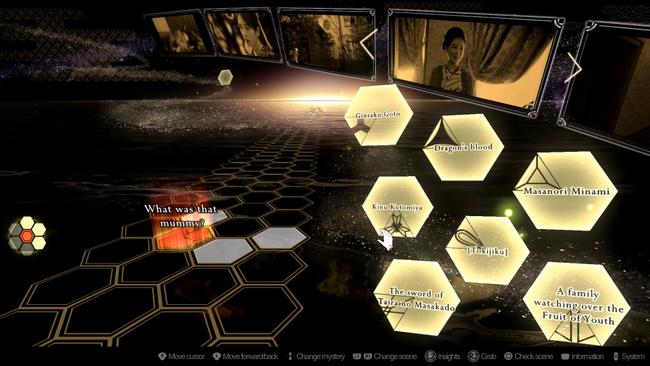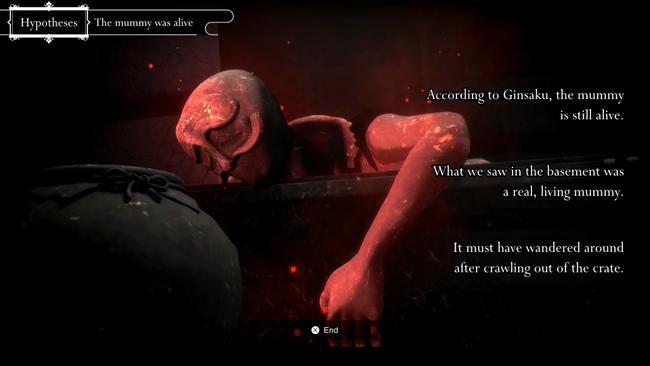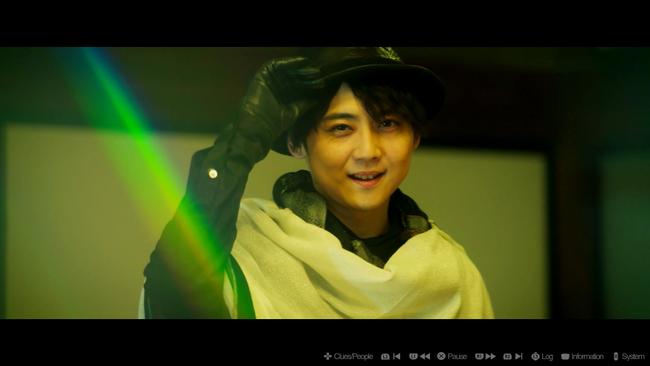
The Centennial Case: A Shijima Story Review
I want to thank whoever was involved in greenlighting the production of The Centennial Case: A Shijima Story. FMV games have seen an upswing recently with titles like Not For Broadcast, Death Come True, and Her Story, but the genre remains incredibly niche. Square Enix announced in February that they were publishing a brand-new high-budget FMV Japanese mystery adventure game by h.a.n.d., the studio responsible for the excellent NEO: The World Ends With You last year. When I first saw Centennial Case, I was thrilled and I knew I had to play it.
Centennial Case revolves around an investigation behind the cursed history that has befallen the Shijima family for a century. Haruka Kagami, a best-selling mystery novelist, is asked by her colleague, Eiji Shijima, to investigate his family’s history upon receiving an invitation to a special succession ceremony that his family conducts every hundred years.
There are two central, fundamental mysteries that Eiji hopes Haruka can uncover: the supposed Fruit of Youth that the Shijimas have passed down for generations and the enigmatic skeletal remains buried underneath the cherry blossom tree where the succession ceremony is held. Eating the Fruit of Youth apparently stops someone from aging and if it actually exists, Eiji wants it for his career in medical research. Meanwhile, the skeletal remains are a grim reminder that the Shijimas hold a long history of suffering a death in the family once every decade.
Haruka and her editor, Akira Yamase, shortly meet the rest of the Shijimas as they visit their estate. The ensuing events that unfold tell an intricately woven tale that reveals the truth about the Shijima family.

Centennial Case is a fantastic game to experience, but a flawed game to play. I mostly loved the 16 hours it took to finish it.
Being a FMV game, much of Centennial Case relies on the presentation and quality of its live-action cutscenes. This is one of the most well-made FMV games I’ve ever seen. Its scene compositions, lighting, and prop work are truly top-notch and masterfully crafted. Studio h.a.n.d. struck a fine balance in building just enough of a somber tone and atmosphere without being too overbearing or heavy-handed in their approach.
One of the unique things that Centennial Case brings to the table, in this regard, is that its narrative shifts between entirely different time periods in certain chapters. For instance, the setup for the game’s first chapter involves Haruka reading a story that was first published in a hundred-year-old magazine. That story’s author was a Shijima, and the Centennial Case re-enacts that story through its FMV scenes.
Since Haruka is trying to imagine what the characters in the story may have looked like, she utilizes the people around her in the present-day Shijima household as a reference. In this way, the Centennial Case smartly repurposes its talented ensemble as they figuratively, and sometimes literally, wear multiple hats throughout the course of the story. Players witness another side to the game’s actors; they don outfits from the Taisho era and take on the role of new characters with different personalities in this instance.

Most chapters in Centennial Case involve a murder mystery. Someone gets unceremoniously killed, and it’s up to players to solve the case. The FMVs will string players along the narrative as the main characters make their initial observations of the body, crime scene, and alibis of all relevant parties. There’s the occasional choice players can make during this part, though they’re usually one-line internal monologue remarks or simple responses to add flavor to a scene.
Once this preliminary investigation phase wraps up, players will enter Haruka’s mind to, quite literally, piece everything together. This manifests as a series of adjacent hexagons forming a road. It’s also where things start falling apart in the Centennial Case.
Several red hexagons are placed along this path asking a question. These represent various mysteries surrounding the case. They usually start with broad ones like, for example, “where was the person killed?” Each red hexagon is connected to at least one gray hexagon, though most are connected to multiple. Players must drag and drop the correct yellow clue hexagon into that slot. Clues are not missable; all available clues are gathered automatically.
Fortunately, this isn’t a matter of mere trial-and-error; every single hexagon has a distinct pattern located on at least one of its six sides. All players have to do is match them with the identical pattern on the red hexagon in the direction where both patterns are facing each other. Correctly connecting mysteries and clues together conjures up a hypothesis. Of course, a hypothesis is not necessarily the truth. It is just a supposition formed by an if-then correlation of the mystery and clue linked.

Going back to the “where was the person killed?” example, a corresponding clue could be “the pool of blood in the room.” This would lead to the hypothesis of “then, this person was killed in the room” because it supposes that if the pool of blood in the room is where the person was killed, then the person must have been killed in the room. Uncovering this hypothesis may open up a new red hexagon down Haruka’s mental road with a new mystery - “the person was killed in the room” and its surrounding hexagons will want evidence that support that statement.
Eventually, a purple hexagon will appear once enough hypotheses have been formed to proceed forward. Be aware that ending these early without finding all hypotheses doesn’t necessarily mean that all the “correct” answers have been found.
The Centennial Case is great at giving players additional miscellaneous in-game resources to aid in their investigation. Elaborate blueprints of relevant places and locales unique to each chapter are provided; places-of-interest are laid out and can be highlighted. Potentially unfamiliar or uncommon terms are detailed in great depth in its glossary. Each chapter comes with its own relation chart too, in order for players to keep track of people's names and relations with one another. If nothing else, the game does an awesome job making players feel like they're detectives.
On paper, it sounds pretty neat. The Centennial Case surfaces the building blocks of employing the logic of deductive reasoning to solve a crime. A lot of the leg work is done for the player, but it’s up to the player when it comes to constructing the chain of reasoning. All formed hypotheses serve as the multiple-choice options when it’s time to unravel the case to the other characters. Several of these hypotheses are visualized as bite-sized scenarios with simple 3D models to further assist players.

In practice, it quickly becomes dull and tedious as players have to scroll through numerous tabs of clues constantly to find the right one to slot in. Sadly, this is what most of the active “gameplay” consists of in The Centennial Case. Piecing together a simple puzzle for roughly 15-20 minutes, sometimes even more, to slowly accrue hypotheses gets old fast. Once players have done it the first few times, this part of the game hardly evolves.
The most difficult part of these sections is when the text of the question is positioned in a way that’s covering up the corresponding symbol, so it takes a hot second to suss out which clue is the right one. Players can also utilize an optional Insight mechanic which has the game highlight the corresponding clue immediately.
It doesn’t help that the cursor speed in Centennial Case on console is terribly sluggish with no option to speed it up. Funnily enough, the PlayStation 5 DualSense controller’s adaptive triggers do come into play here when players grab a hexagon.
I won’t go into detail about it so as to not spoil the surprise; there is a specific chapter later in the Centennial Case that adds on a substantial amount of new gameplay elements, but it’s only exclusive for that part. I wish more of those aspects were sprinkled into the rest of the game. It would’ve substantially mitigated a lot of my issues surrounding its lackluster gameplay inside Haruka’s mind.
After conjuring up a bunch of hypotheses, the game does one final check to see where the player’s reasoning lies. It’ll ask a series of basic questions about what they found unusual about the case, which mystery they found intriguing, and a final hypothesis that can be surmised from the aspects that stood out to them. There’s no right or wrong answers here that will prohibit players from proceeding; it effectively serves as a notepad to lightly guide players into considering a certain angle or mindset. I didn’t really see why this was necessary to include, but it’s harmless nonetheless.

From here on, players must now finally get to the bottom of things. The relevant characters in each chapter gather as Haruka, or the character Haruka is roleplaying, identifies the killer and provides evidence as to why that person is the killer. There is only one correct answer in all of the choices the player is presented with from here on out.
Any incorrect selection leads to an almost immediate “bad end” screen that plays a more jokey background song to signify that it was the wrong choice and the FMV ends with the protagonist stumbling over their words as they realize their mistake. Players can receive a Revelation to point them to the right answer next time, if they want.
Then, players are sent back to Haruka’s mind with the hexagon path; it is left in the same exact state as players first left it, so if it was completely filled out the first time around, it should still be that way. All players would have to do is scroll back to the end and fill in the purple hexagon to finish it once more. There is also the option to redo the small reasoning summary too. Players won’t have to redo unraveling the truth from the start. Instead, they will be transported back to the cutscene that led up to the decision they got wrong. Skipping the cutscene will bring up those choice selections immediately.
Making the wrong choice and retrying it took roughly 8-10 seconds on PlayStation 5. The load times on the Nintendo Switch version make this process closer to a more frustrating half a minute. I would have preferred the “bad end” screen to just add the option to redo the decision again, instead of giving players no choice but having to skedaddle back to it.
Thankfully there’s not a significant penalty for choosing the wrong options in the grand scheme of things. Players are evaluated and given a grade at the end of each chapter. Using Insights, Revelations, and choosing incorrect choices subtract from it, but it’s only there for players to self-evaluate their detective skills. Getting a low grade will not alter the story in any way, shape, or form.
One of Centennial Case’s strongest aspects is in its music. A lot of moments are elevated splendidly thanks to its beautiful intensity. The game’s narrative demands that it has to account for changes in time period and era as well. There is a key chapter that heavily revolves around a nightclub diva, in which its music naturally adapts. Centennial Case has such an outstanding understanding of finding a unique theme to its melodies that is simply sublime to listen to. I think it’ll end up being one of my favorite soundtracks this year.
On the technical front, this is where things get murky between Centennial Case’s platforms. The file sizes for its PS5 and PS4 versions are roughly 63GBs and 15GBs respectively, presumably because the video quality of its FMVs are 4K on PS5 and 1080p on PS4. Its Switch version is also around 15GBs, which is understandable. Now for its PC release on Steam, the Centennial Case is still shockingly around 15GBs, which seems to suggest that the PC version’s FMVs are only 1080p. As of the time of this review, the PS5 version remains the best version when it comes to visual fidelity because it’s the only platform that has 4K FMV scenes; Square Enix has not announced any plans to patch the PC version of Centennial Case to bring its FMV scenes to 4K.
The Centennial Case does offer a full English dub too. Sadly, I can’t recommend playing the game with it on. It faces the same difficulty many live-action audio dubs are confronted with - inconsistent lip-syncing and mismatched voices for some characters. A lot of the Centennial Case’s English voices are decent, but several of them come off too comical. It’s to the point that I found it detrimental to a lot of important scenes, so I would strongly suggest playing with Japanese audio.
There are also a few issues with subtitle timings for a small handful of scenes. The English subtitles sometimes ended too early or started too late. A robust scene navigation system helps mitigate this problem though. Players can instantly rewind or fast-forward in five-second segments at any time; plus, a chat log updates in real-time allowing players to pause mid-scene and read up all the dialogue that was previously spoken.

Lastly, I have to mention that the Centennial Case has a post-credits epilogue scene that, I kid you not, is reminiscent of Metal Gear Solid 4. I will not elaborate any further. It made me love the game even more after it was completely finished.
The Centennial Case: A Shijima Story is an exceptional game in almost every way. I want to sing the praises of this game far and wide, yet its “gameplay” sections largely hold it back from being an absolute masterpiece. The story it presents is gripping and tragic. Its cast is marvelous in delivering their performances, even when faced with the monumental task to play entirely separate characters in different time periods. Everything about its music is stunning. There are so many amazing aspects to this high-budget FMV mystery adventure, but its execution on what it has players do to solve its various mysteries is truly its biggest Achilles’ heel.